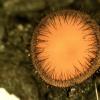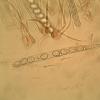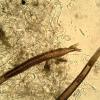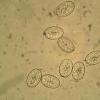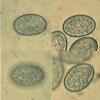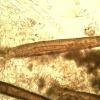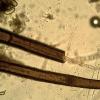
12-11-2021 00:03
Lepista ZacariasHi everybody,A week ago in my fiels trip I noticed

29-12-2025 17:44
Isabelle CharissouBonjour,J'aimerais savoir si d'autres personnes au

29-12-2025 17:12
 Bernard CLESSE
Bernard CLESSE
Bonjour à toutes et tous,Pourriez-vous m'aider à

29-12-2025 17:01
Gernot FriebesHi,I'm looking for help with this hyphomycete with

29-12-2025 08:30
Hello.A tiny ascomycete sprouting under Juniperus

29-12-2025 10:15
Hulda Caroline HolteHello, I found and collected this propoloid ascom

29-12-2025 09:38
Oskari VirtanenHi,could anyone help me identify this, I suspect P
Scutellinia
Malcolm Greaves,
21-05-2013 18:55
The spores averaged 18.5 x 12.3 and had small sometimes interconecting warts.
There were three distinct types of hair, firstly long 1200um then short 250 -400 and finally very short and rounded.
This lead me to S critina but the unusual find was that some of the small hairs were growing inside the longer ones. On checking Schumacher it is apparently not unusual and cannot be used in helping to identifying to species but it is the first time I have seen it.
Mal
Michel Delpont,
21-05-2013 20:14

Re : Scutellinia
Good evening Malcolm
Your fungus also makes me think S.crinita I harvested a few days ago. Beautiful species with the long hair.
Michel.
Your fungus also makes me think S.crinita I harvested a few days ago. Beautiful species with the long hair.
Michel.
Beñat Jeannerot,
21-05-2013 21:03

Re : Scutellinia
Dear Malcolm,
S. crinita.
About hairs inside others, it's a very common fact in this genus. Not a discriminate factor.
Regards,
Beñat
S. crinita.
About hairs inside others, it's a very common fact in this genus. Not a discriminate factor.
Regards,
Beñat


